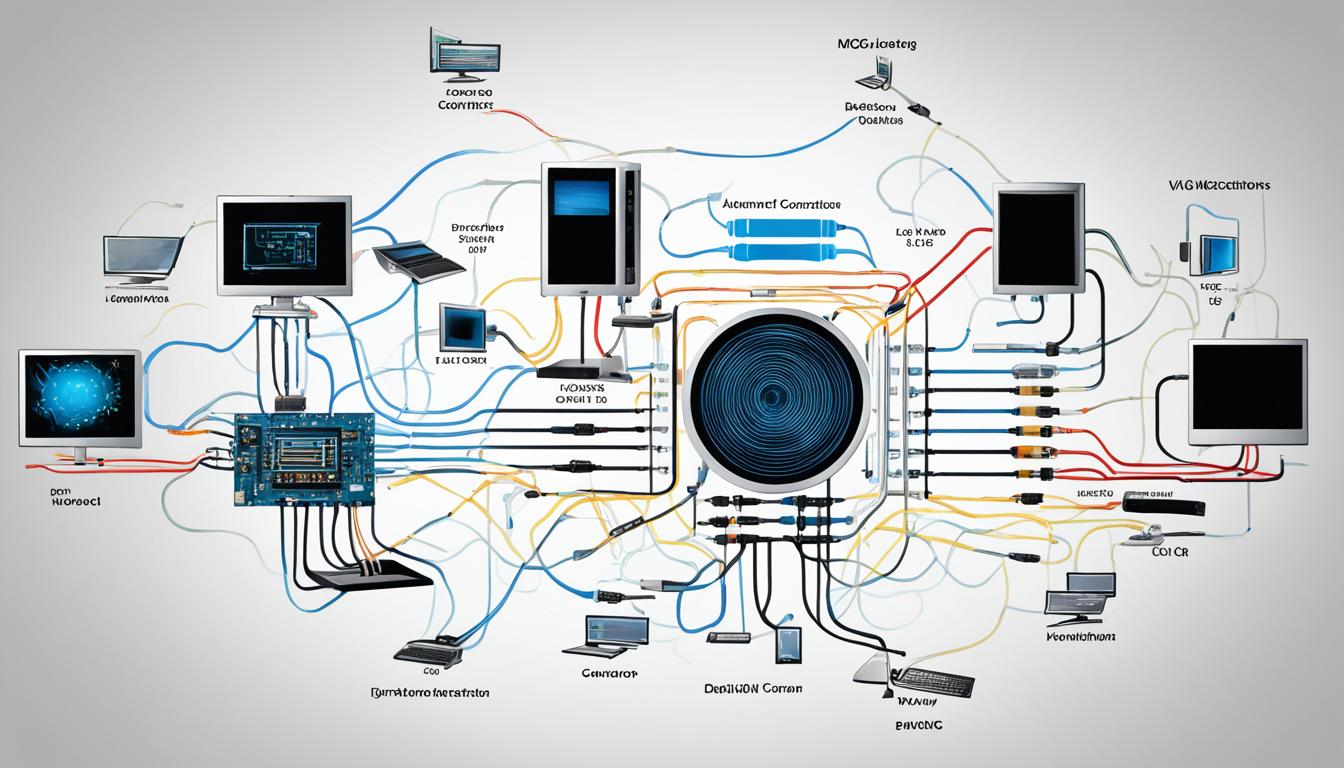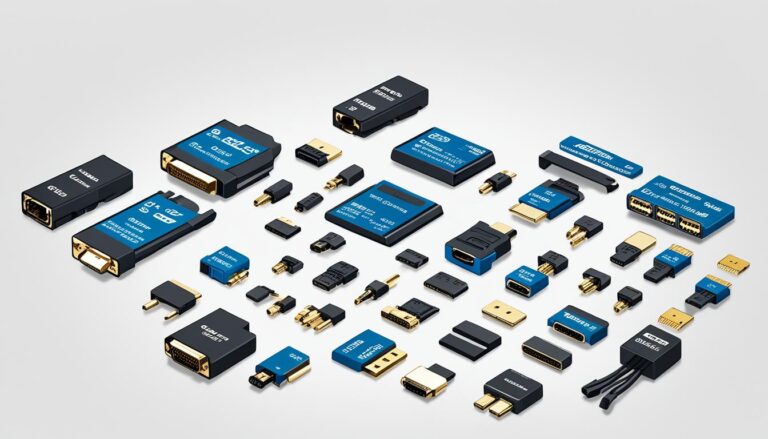Welcome to our top guide on monitor connections. This article will cover all the different monitor connections you can find today. We aim to give you a clear visual and technical look at each type. Whether you’re installing a new monitor or upgrading, knowing about connections is key. Let’s explore the world of monitor connections together!
Before we dive in, let’s get to know some key terms: monitor connections, types of monitor connections, and visual and technical guide. We’ll use these keywords throughout our text. This will help with SEO but keep the text easy to read and understand.
HDMI: The Best Connector for Audio and Video Signal
HDMI stands for High Definition Multimedia Interface. It’s the top choice for transmitting audio and video signals. It’s great for linking TVs and PCs, delivering high-quality sound and clear images.
HDMI is versatile and supports long cables without losing signal quality. This is perfect for TV to PC connections. You get a seamless viewing without interruptions.
HDMI cables do more than show videos. They also send out audio, including multi-channel sound. This makes movies, TV shows, and games more immersive.
Also, HDMI can carry ultra high resolutions. This is good for watching films or doing graphic work. It ensures sharp image quality for all details.
It can also send 3D images, making games and entertainment more real. You get visuals with depth and realism.
In conclusion, HDMI is the best for sending audio and video, especially from TV to PC. It handles long cables, high-quality audio, ultra high resolutions, and 3D images well. This provides a top-notch viewing experience.
DVI: Perfect for Video Only and Older Systems
DVI, or Digital Visual Interface, is great for old systems. It focuses on video transfer, making it great where that’s all you need. Since it does not send audio, it’s perfect for video-only setups. DVI handles both analog and digital signals well. This lets it work with many devices, giving you clear images on your screen.
There are different DVI connectors for various needs. Single Link DVI works for up to 1920×1080 pixel displays. That covers most HD screens. Dual Link DVI goes even further, handling up to 2560×1600 pixels. This is ideal for high-resolution displays. DVI is a solid choice whether you have an old system or care most about video quality.
Advantages of DVI:
- Perfect for older systems without audio capabilities
- Ideal for scenarios that require video-only transfer
- Supports large resolutions and high frequencies
- Different connectors available for various resolution requirements
Summary
DVI shines for video-only tasks and older systems that don’t handle audio. It deals well with large resolutions and high frequencies. DVI excels whether using a high-end monitor or an old setup. It ensures a smooth and clear visual experience.
DisplayPort: The Best Connector for High Resolutions and Audio
DisplayPort leads in monitor connections for those wanting top-quality resolution and sound. It suits both home and workplace needs perfectly.
It shines with its support for very high resolutions. This makes it a top pick for gamers, graphic designers, or anyone who loves great visuals. DisplayPort offers an experience that brings visuals to life.
DisplayPort is the go-to choice for users who demand the best in terms of quality and performance. With its support for high resolutions, every detail comes to life, ensuring a truly remarkable viewing experience.
DisplayPort is also great for audio. It sends audio without needing extra cables. This means less clutter and an easier setup.
DisplayPort cables can be longer than others without losing signal. This lets you arrange your workspace just how you like it, without giving up performance.
Desktop PCs and laptops often have DisplayPort connectors. They come in both full-size and mini, fitting various devices. Its lower licensing fees make it popular among manufacturers.
DisplayPort vs. HDMI
DisplayPort and HDMI have their differences. DisplayPort can handle higher resolutions and refresh rates. HDMI is more common in TVs and entertainment systems.
| Features | DisplayPort | HDMI |
|---|---|---|
| Resolution and Refresh Rates | Supports very high resolutions and refresh rates | Limited support for high resolutions and refresh rates |
| Audio Transmission | Transmits audio signals | Transmits audio signals |
| Cable Length | Longer cabling capabilities | Limited cable lengths without signal degradation |
| Licensing Fees | Lower licensing fees | Higher licensing fees |
Choosing between DisplayPort and HDMI comes down to what you need. DisplayPort is best for high-quality visuals, sound, and flexible setups. HDMI suits consumer electronics better.
Make sure your devices and cables match to avoid issues. Always check with the manufacturer for the best advice.
For the ultimate visual and audio setup, DisplayPort is the way to go. It leads with high-resolution support, sound, and long cables. It’s the top choice for a top-notch monitor connection.
USB-C and Thunderbolt: Versatile Connectors with Data and Power Capabilities
USB-C, also known as Thunderbolt-3, is a versatile connector. It transfers video and audio while handling data and power. This makes it a top choice for Macintosh computers and Windows PCs.
Users can connect many devices with USB-C ports. These include external displays, smartphones, tablets, and laptops. Its ease of use has made it famous in the tech world. You can link your laptop to a bigger screen or charge your phone with the same wire.
But, when it comes to the best picture and sound, HDMI and DisplayPort are better. They can manage higher video and sound qualities, offering an immersive experience. So, USB-C and Thunderbolt are great for many tasks. Yet, for the top audiovisual quality, think about HDMI and DisplayPort.
FAQ
What are the different types of monitor connections available?
You can find many monitor connections like HDMI, DVI, and DisplayPort. VGA, USB-C, Thunderbolt, AV, NDI, and SDI are also available.
What does HDMI stand for and what is it used for?
HDMI means High Definition Multimedia Interface. It’s great for connecting TVs to PCs. It ensures high-quality sound and image transmission.
What are the features of HDMI cables?
HDMI cables support long distances and multi-channel sound. They also handle ultra-high resolutions and 3D images well.
What is DVI and when is it recommended?
DVI stands for Digital Visual Interface. It is great when you need good video quality. It works well with older systems.
DVI cables carry analog and digital signals. They support big resolutions and high frequencies too.
What are the different types of DVI connectors?
Different DVI connectors exist. Single Link DVI is for resolutions up to Full HD. Dual Link DVI is for even higher resolutions.
What is DisplayPort and why is it considered the best connector for high resolutions?
DisplayPort is top-notch for high resolutions and sound. It supports very high resolutions. It also transmits audio signals well, over long cables.
Where can I commonly find DisplayPort connectors?
DisplayPort connectors are mostly seen on desktops and laptops. They come as standard and mini versions.
What is USB-C and Thunderbolt?
USB-C, also known as Thunderbolt-3, does a lot. It handles video and audio, and also data and power. It’s common on modern Macs and PCs.
What can I connect using USB-C ports?
USB-C ports let you connect many devices. These include displays, smartphones, tablets, and laptops.
Are HDMI and DisplayPort still preferred options for display and sound quality?
For top-notch display and sound, HDMI and DisplayPort are best. While USB-C is convenient, it doesn’t beat them in video and sound quality.












